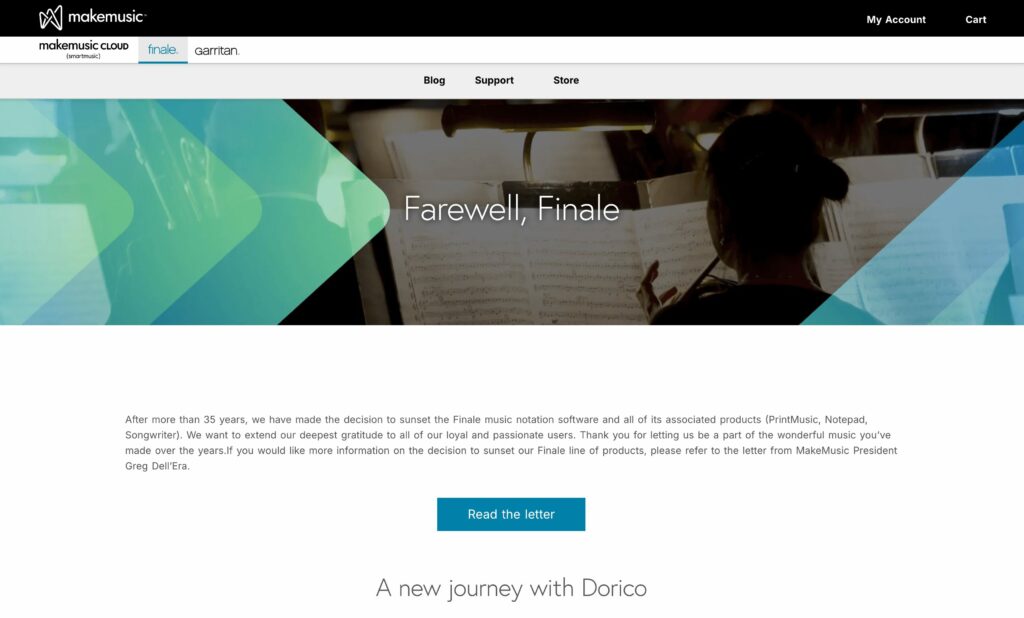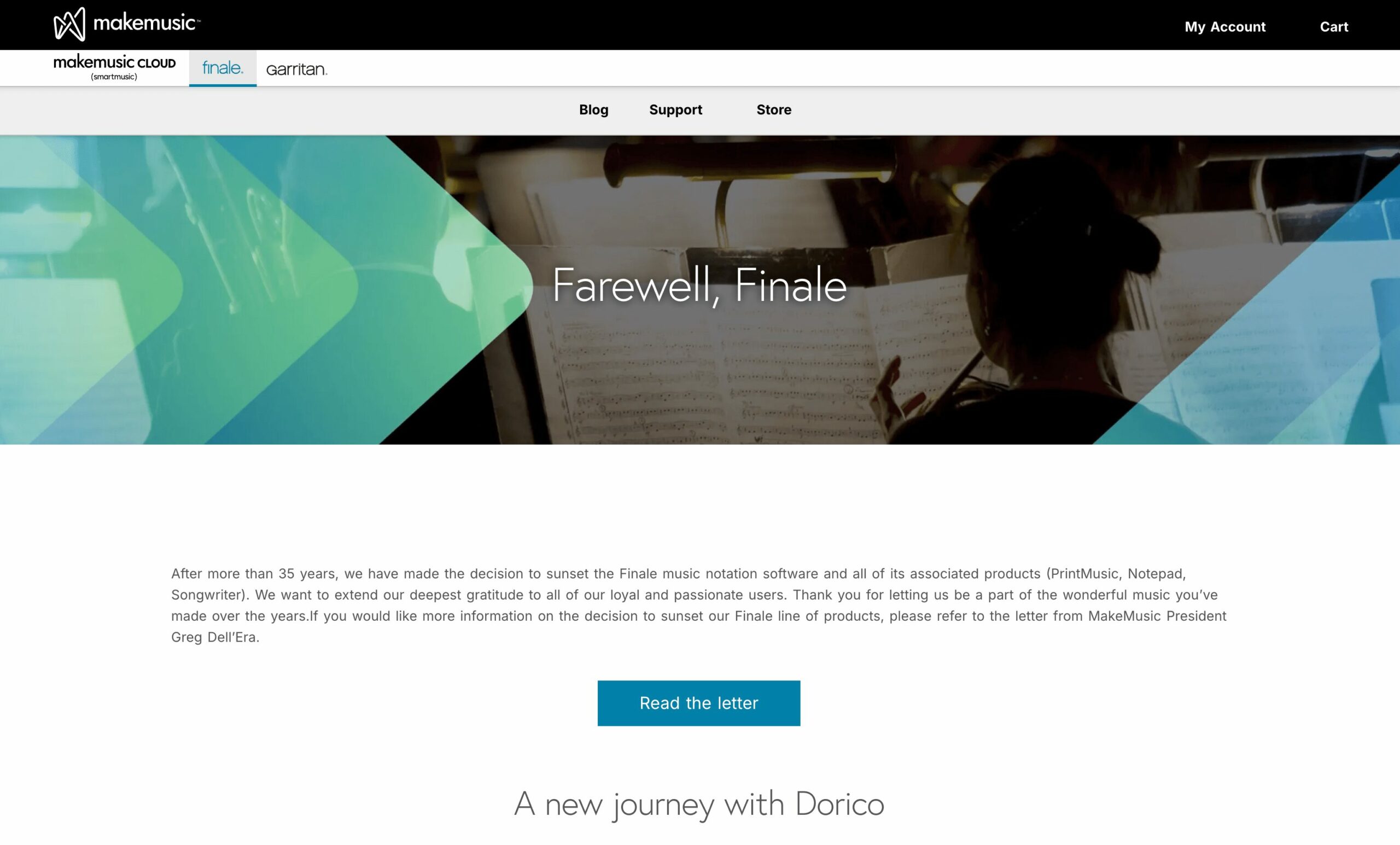A major software shutdown has been rocking the music/composition world over the past 24 hours – one of the major players in composition software, Finale, has announced it is shutting down completely.
This surprise announcement has certainly generated a large community response – from surprise to outrage to a lot of people looking for alternatives.
In this blog post I’ll cover some possible alternatives (but I am not a serious composer of large ensemble works), as well as some of the lessons that may be worthing taking from the sudden closure of such an important product for so many people.
Finale – A Short History
Founded in 1988, Finale was one of the first (and one of the most popular) music notation software suites.
Finale, along with Sibelius were the two big players in music notation software for most of my years as a student (late 1990’s – 2006). While Sibelius was a late arrival (released in 1993 for the UK-based Acorn computer platform and released on Windows in 1998), it differentiated itself from Finale in having an easier, more gradual learning curve. It was (in my experience, at least) just as powerful – it just made it simpler to do “basic” things.
This led to many serious composers and arrangers becoming either “Team Finale” or “Team Sibelius”.
The Sudden Shutdown
Yesterday, August 26, Finale posted this to their homepage:

And also posted this blog entry: The End of Finale – Finale. The text read (in part):
Today, Finale is no longer the future of the notation industry—a reality after 35 years, and I want to be candid about this. Instead of releasing new versions of Finale that would offer only marginal value to our users, we’ve made the decision to end its development.
Ostensibly, this makes ending Finale – while frustrating for current users – seem almost noble. Instead of constantly making minor upgrades (and charging ever-increasing prices), Finale will gracefully bow out. Except for a couple of notable terms:
- Effective immediately, “It is no longer possible to purchase or upgrade Finale in the MakeMusic eStore“.
- And in one year, “It will not be possible to authorize Finale on any new devices, or reauthorize Finale“.
Both of these rightfully upset users.
Not only did Finale become impossible to acquire (legally) overnight without any prior warning, but a perfectly-functional version of the software would become impossible to install on (otherwise compatible) hardware in a year. While this did mean that users could – in theory – continue to use Finale for the foreseeable future, if a computer crashed or Finale needed to be reinstalled for any reason, it would be impossible for users to use their legally-purchased software after a very short time. Very bad news if your a composer or arranger on a project with a tight deadline.
Finale Shutdown Updates (As of August 27)
Earlier today (August 27) Finale updated the terms of Finale’s shutdown.
Probably the biggest one is that “Finale authorization will remain available indefinitely“. This means that – barring any sort of OS updates that break compatibility – it seems like users will be able to user Finale for the foreseeable future. There will not be a 1-year limit for activating new installations.
This does not mean that Finale users should continue to use Finale! Any sort of operating system update (by either Microsoft or Apple) that breaks Finale’s functionality (or causes weird errors) will not be fixed by Finale. This could still leave users in the lurch if an OS update breaks some critical functionality in the middle of an extensive project.
However, this does mean that if you can manage to keep a Mac or PC on a compatible operating system, you’ll be able to reinstall Finale for the foreseeable future. This is definitely much better – especially for users with dozens (or hundreds) of scores that they were worried about converting to work in different notation software.
Moving on from Finale
MakeMusic – the parent company that owns Finale – has recommended users upgrade to Dorico Pro (not Dorico Elements) which normally costs $580, by lowering the cost to $150.
Also on August 27, MakeMusic also announced that users who purchase Dorico Pro (through their MakeMusic account) will also get a free copy of Finale v27. This is very useful for users who may want to upgrade, but would also like the latest version of Finale just in case they would prefer to keep using Finale as long as possible. It’s not quite the same as making the Finale still available to purchase for new users, but it should give current Finale users at least a small lifeline to get a copy of the final version of Finale.
Of course, there are other options for notation software.
Sibelius is, of course, a likely destination for many ex-Finale users. However, it is worth pointing out that, unlike Finale, Sibelius operates on the SaaS (software-as-a-service) subscription model. If this is your tool of choice (and you’re a professional) this is an annoying business expense. If you are an amateur or just write music for fun, however, it becomes much less likely that you will want a recurring subscription for notation software.
MuseScore is my notation software of choice (however, I am not a professional composer or arranger). While it has served me pretty well (especially for the price), I have heard from composer/arranger friends that other options handle larger ensemble scores and more complex notation demands much better than MuseScore. However, since I don’t do any real large ensemble arranging, I would trust their opinion over mine.
Lessons Learned
Since this shutdown of Finale was so sudden and disruptive (although some of the most disruptive changes have been walked back), this is a cautionary tale to keep in mind for any industry or job where your tools are software-based (which are easily modified) and proprietary (which means you don’t have control).
Some things that I try to consider that may be useful in a situation like this (or moving forward):
- Never stop learning about new things in your field. This doesn’t mean to become obsessive, but every 3-6 months, take a look at what has just come out or what is “on the horizon”. When you have some free time, spend a day or weekend playing around with the new thing. This will give you an idea of what to do if the rug is pulled out from under you suddenly.
- Have a backup plan or reverse clause with as many “mission-critical” things as possible. If your hard drive crashed, is your data somewhere safe? If your main computer/tablet was destroyed or put out of commission, do you have a backup (see the Crowdstrike debacle)?
- When possible, use open-source systems (or at least become familiar with them). While open-source software is not perfect and usually comes with noticeable tradeoffs (often in the areas of user experience and ease of use), these projects are quite durable. Since they are worked on by a community, there is (usually) no single point of failure, and if one version of a project does shut down, a “fork” of that project will often be created and continued by other motivated developers.
- When possible, try and work with businesses, products, and software whose interests align with yours. This is often challenging to do, as it seems like the main interest of many businesses is “recurring revenue” (i.e. subscriptions), but it is worth noting. The reason why I (happily) have moved on from Windows to Mac OS (and Linux) is that Microsoft seems primarily concerned with turning Windows into an advertising platform for users of its “modern” OSes (like Windows 10 and 11) while keeping tons of old, insecure code to make sure that it doesn’t break an old application written for Windows XP. Other operating systems – also run by marketing companies – have no qualms with starting, abandoning, and then shutting down products that don’t get 100 million users (which is what it takes to make these products useful as marketing tools). Since these interests don’t align with mine, I try to avoid using these products as much as possible.


Leave a Reply
You must be logged in to post a comment.